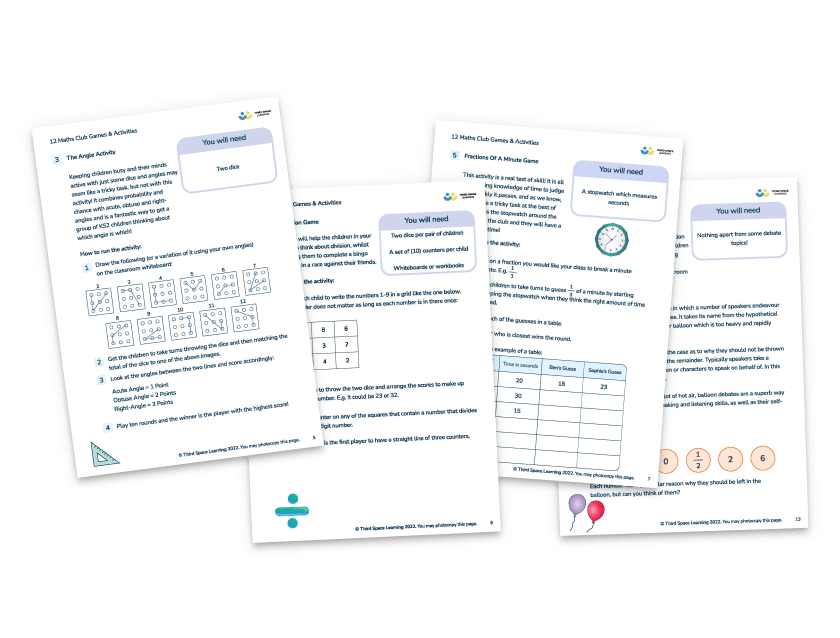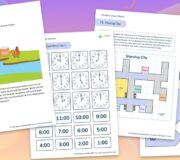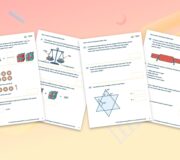7 Football Maths Activities For KS2 Followers Of The UEFA Euros
As the UEFA Euros 2024 captures the attention of football fans across the UK, and likely your pupils, we’ve put together a collection of football maths activities and maths challenges to bring the tournament’s excitement into the classroom.
As AI maths tutoring specialists, Third Space Learning understands the importance of making maths relevant and accessible to pupils. The Euros are the perfect example to demonstrate to your class how maths is woven within the world around them and provide the opportunity to build on crucial mathematical skills and knowledge through football-themed maths activities.
The national curriculum links are recommendations only. Many of these teaching resources have opportunities for adaptation and differentiation for different years as required.
Crucially, we’ve included all the data you’ll need so you shouldn’t need to spend long preparing these activities.
If you want a more ready-to-use, designed version of all these, the Euros 2024 maths resource is available for free download: Euros 2024 Maths Activities
KS2 Topical Maths Problems For The UEFA Euros 2024
7 real world UEFA Euro maths activities for KS2 complete with sample data, tables to complete, answers and all the guidance you need.
Download Free Now!UEFA Euros maths activities for KS2
These Key Stage 2 football maths activities aim to strengthen essential skills and problem solving while linking national curriculum maths topics to real-world contexts. Pupils can explore fractions, decimals, and percentages as they look at match statistics, work out distances between host cities, and even plan a budget for a fan’s dream trip to the tournament.
Third Space Learning’s primary AI maths tutoring lessons are designed to scaffold pupil learning using an ‘I do, we do, you do’ approach to enable them to develop the skills they need to complete independent practice. At this stage, Skye, the AI maths tutor, supports pupils to apply their learning to problem-solving and reasoning questions, incorporating real-life applications of their learning.
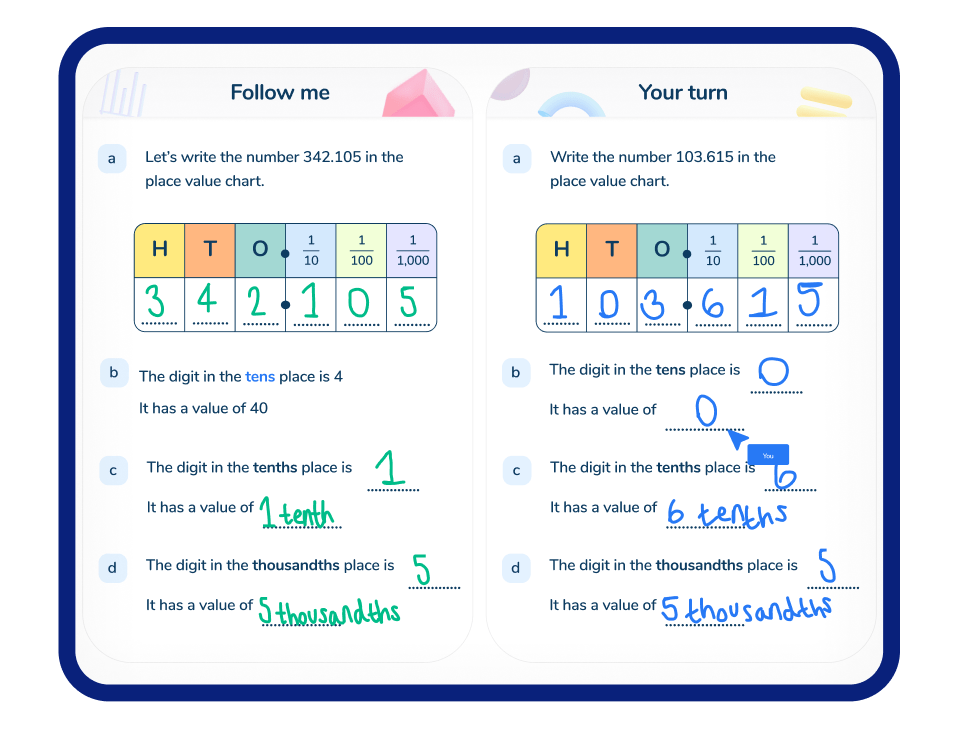
1. Tournament bracket calculation
National curriculum link: Year 3 Addition and Subtraction: Pupils practise solving varied addition and subtraction maths questions.
Duration: 15 minutes
Activity description: Pupils will calculate the total number of matches played in the tournament, considering group stages, knockout rounds, and finals.
Instructions:
- Explain the structure of the UEFA Euros tournament: group stage, knockout rounds, and final.
- Discuss the format of the group stage (6 groups of 4 teams each) and the knockout stage.
Data collection:
- Provide pupils with the structure details.
- Example data:
- Group Stage: 6 groups x 6 matches = 36 matches
- Round of 16: 8 matches
- Quarter-finals: 4 matches
- Semi-finals: 2 matches
- Final: 1 match
Calculating total matches:
- Pupils add up the matches from each stage to find the total number of matches played in the tournament.
- This activity could be extended to calculate other totals, such as the number of players involved in each round.
Discussion questions:
- How many matches are played in the group stage?
- How does the knockout stage structure affect the total number of matches?
Data sources:
- Official tournament structure: UEFA
Answer:
There are a total of 51 matches played in the tournament.
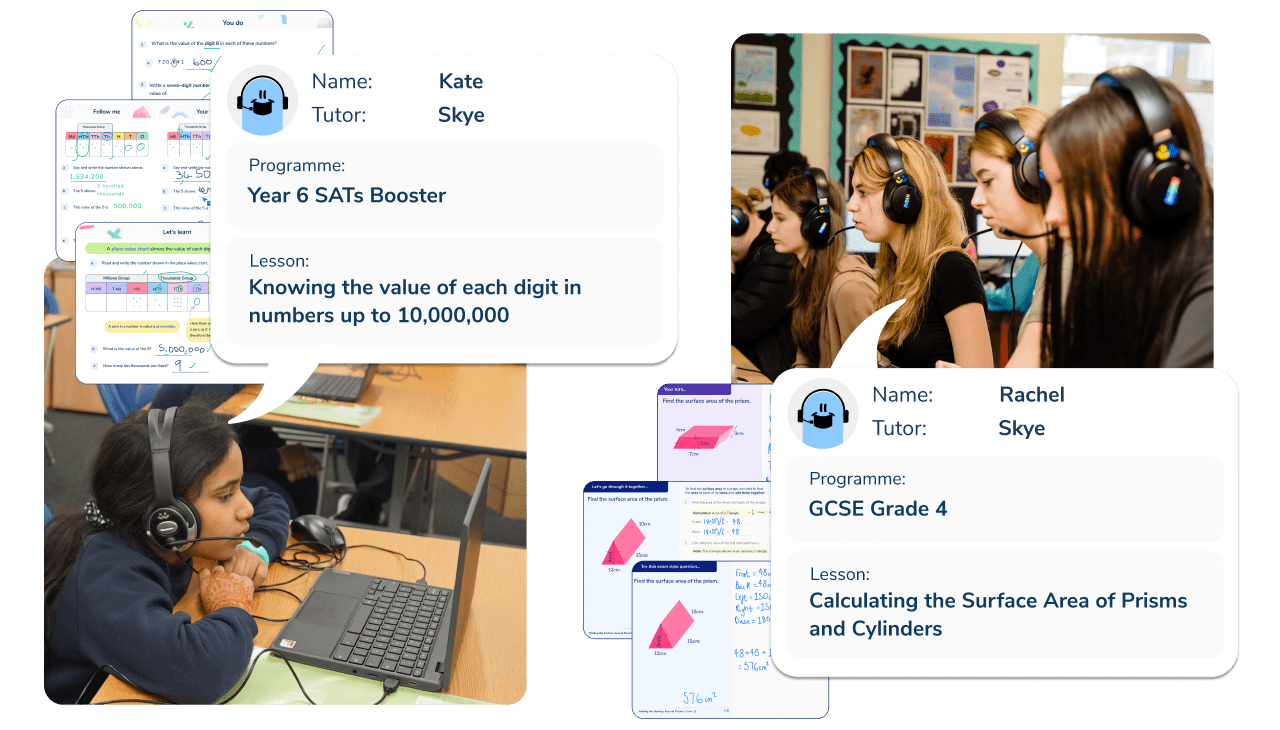
Meet Skye, the voice-based AI tutor making maths success possible for every student.
Built by teachers and maths experts, Skye uses the same pedagogy, curriculum and lesson structure as our traditional tutoring.
But, with more flexibility and a lower cost, schools can scale online maths tutoring to support every student who needs it.
Watch Skye in action2. Match results analysis
National curriculum link: Year 3 Statistics: interpret and present data using bar charts, pictograms and tables
Duration: 45 minutes
Activity description: Pupils will analyse the results of matches from the UEFA Euros 2020. They will work with win/loss/draw data, goal differences, and points to understand how teams progress through the tournament. This can be adapted to include the current 2024 data where desired.
Instructions:
- Explain the structure of the UEFA Euros tournament: group stage, knockout rounds, and final.
- Group Stage: 6 groups x 6 matches = 36 matches
- Round of 16: 8 matches
- Quarter-finals: 4 matches
- Semi-finals: 2 matches
- Final: 1 match
- Provide a brief overview of how points are awarded
- win = 3 points
- draw = 1 point
- loss = 0 points
- Explain that the:
- Goals For (GF) show the number of goals scored in their matches.
- Goals Against (GA) show the number of goals scored against the team.
- Goal Difference (GD) is the difference between the GF and GA. This is used to indicate overall performance.
- GD is used as a tiebreaker if teams have the same number of points in the standings.
- Provide pupils with match results from the group stage.
Example data for Group A from the UEFA Euros 2020:

Data analysis:
- Ask pupils to calculate the goal difference (GD) for each team.
- Calculate the number of points each team has been awarded (each game won is 3 points, each draw is 1 point and each game lost is 0 points). Have pupils create bar charts to visually represent the points of each team.
- Discuss which teams advanced to the knockout stages based on their points.
Data sources:
- Official UEFA Euros 2020 results: UEFA
Answers:

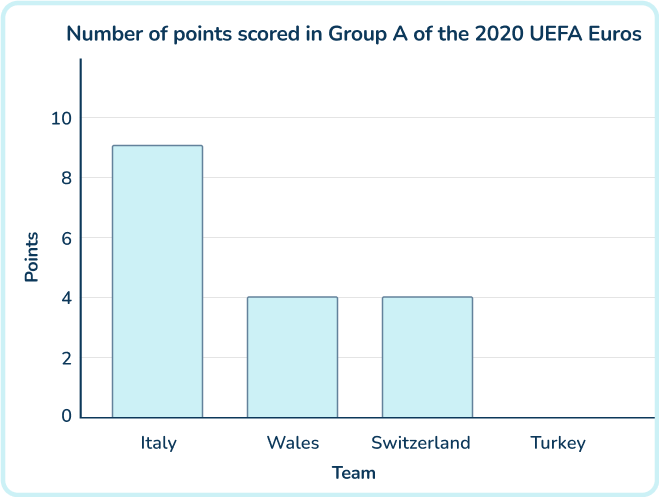
3. Graphing player statistics
National curriculum link: Year 3 Statistics: interpret and present data using bar charts, pictograms and tables AND Year 6 Statistics: interpret and construct pie charts and line graphs and use these to solve problems
Duration: 60 minutes
Activity description: Pupils will create graphs (bar graphs, line graphs) based on player statistics such as goals scored, assists, and minutes played during the UEFA Euros 2020. This can be adapted to include the current 2024 data where desired.
Instructions:
- Explain the importance of player statistics in football (they help determine team strategies and tactics, identify player development, identify scouting and recruitment opportunities etc).
- Discuss different types of statistics (goals, assists, minutes played, etc.).
Data collection:
- Provide pupils with player statistics.
Example data from 2020:
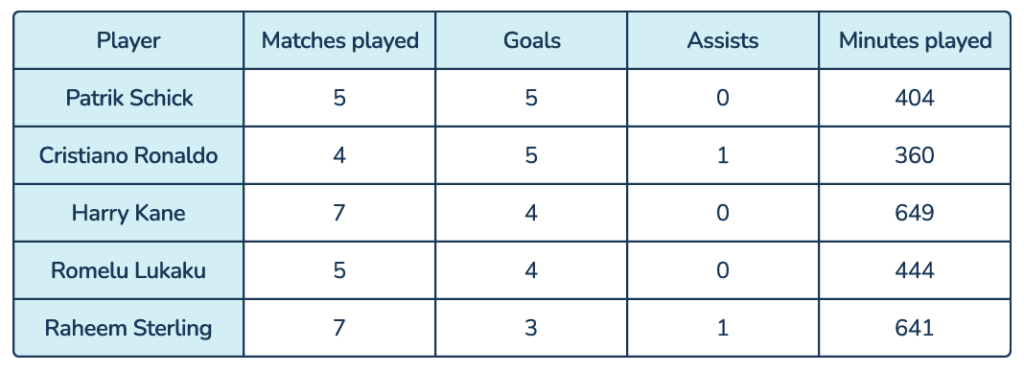
Graph creation:
- Have pupils create bar graphs to compare the number of goals scored by each player.
- Use pie charts to represent the proportion of goals scored by top players (note that pupils may want to discuss who the ‘top’ players are and how that is defined). .
Discussion questions:
- Which player scored the most goals?
- How does the number of assists compare between players?
- Which player had the most playing time?
Data sources:
- Official UEFA player statistics: UEFA
Answers:
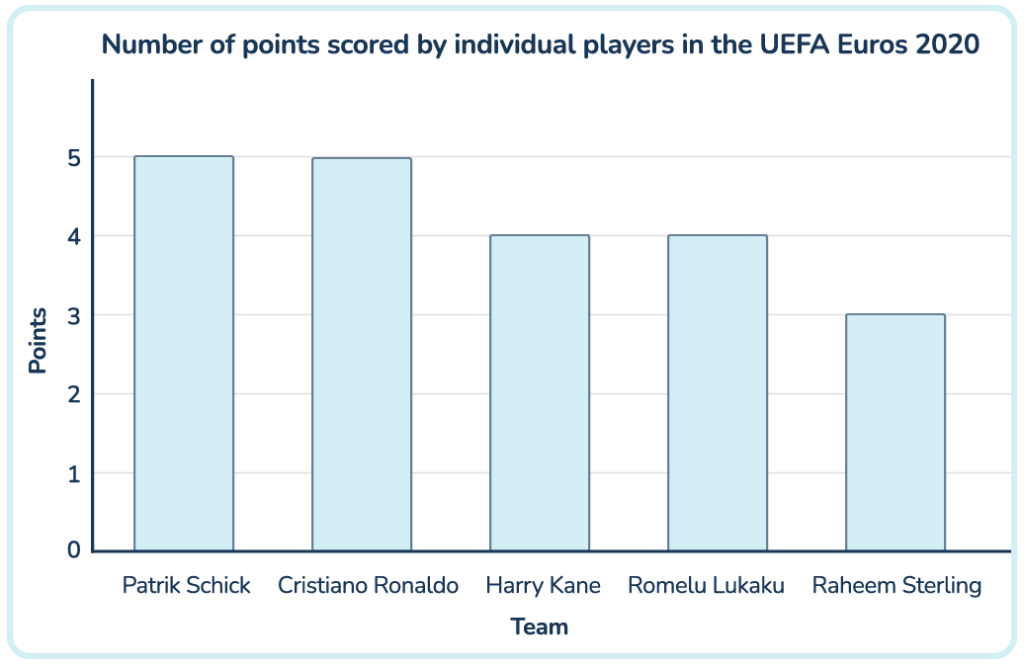
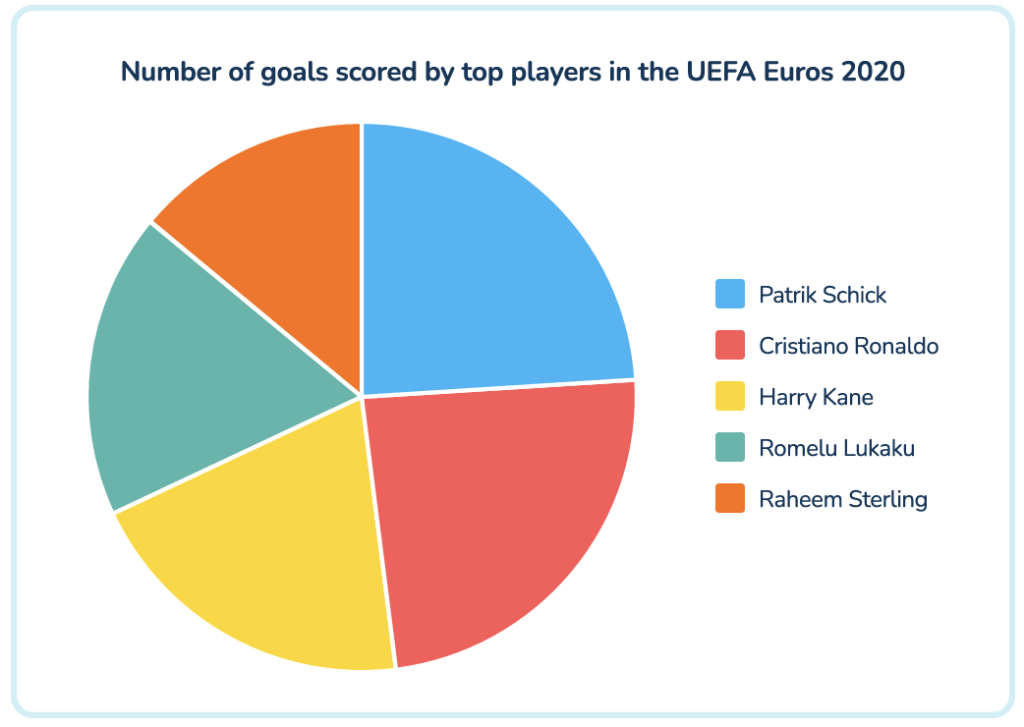
4. Time zone differences
National curriculum link: Year 4 Measurement: read, write and convert time between analogue and digital 12- and 24-hour clocks
Duration: 30 minutes
Activity description: Pupils will calculate the time differences between various host cities and convert match start times to their local time.
Instructions:
- Explain the concept of time zones and their importance in scheduling international events. Discuss how time differences can affect match timings.
Data collection:
- Provide pupils with a list of match start times in British Summer Time and corresponding time zones for the teams playing.
Note that to extend the challenge of the task, change all start times to Central European Summer Time (BST +1) as these are the start times in Germany.
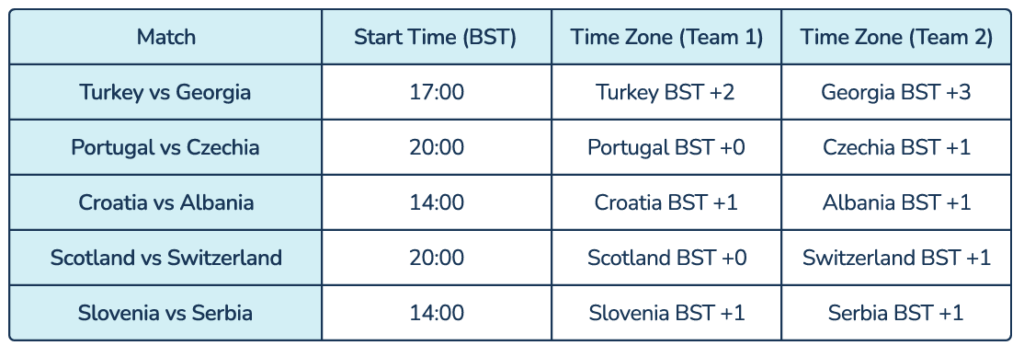
Time conversion:
- Pupils convert the local start times to their local time.
- Example: Italy vs Türkiye starts at 21:00 CET. If pupils are in London (BST), the match starts at 20:00 BST.
- Tell pupils to write the times in 12-hour and 24 hour time.
- To extend this activity, direct pupils to calculate the approximate end times of matches (or actual end times of matches if data is available).
Discussion questions:
- What is the local time for each match in London?
- How do time zone differences impact fans watching from different countries?
- Why is it important to understand time zones?
Data sources:
- Time zone information: Time and Date
Answers:
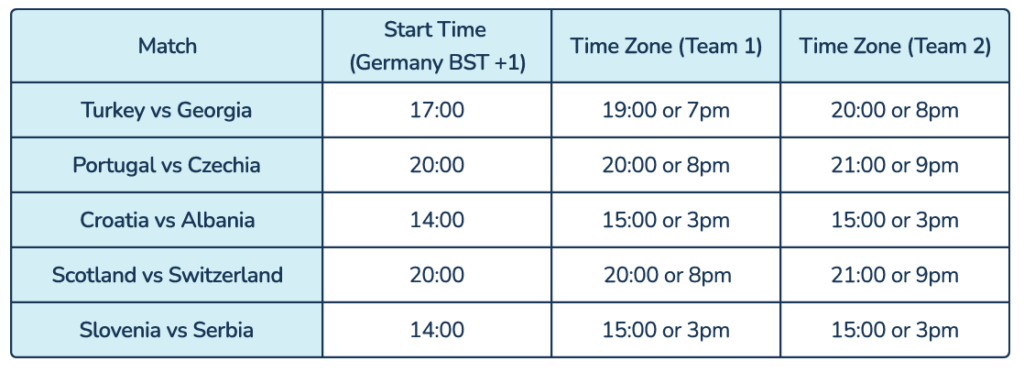
5. Fan budgeting exercise
National curriculum link: Year 4 Measurement: estimate, compare and calculate different measures, including money in pounds and pence
Duration: 60 minutes
Activity description: Pupils will budget for a fan travelling to the Euros to watch their team play.
Instructions:
- Explain the concept of budgeting and why it is important generally and when planning out a potentially costly trip.
Data collection:
- Provide pupils with a hypothetical scenario. They are a fan flying from London to Cologne to watch England play at least one match in the Euros. They will stay for a week and will watch England play and one other match. They have a total budget to spend for the week of £2,000 (this can be adjusted up or down if you wish).
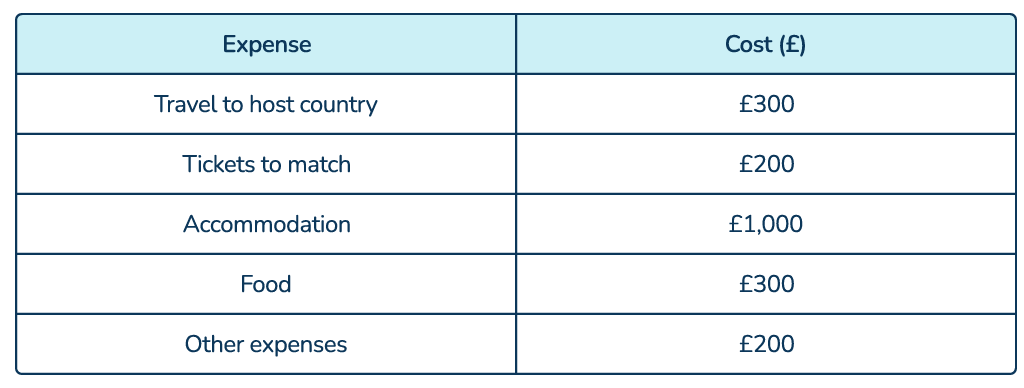
Budget allocation:
- Pupils allocate funds to different categories of their trip. They could research the different elements (flights, hotels, restaurants, tickets, merchandise, travel around Cologne etc) or you could give them a selection of fictional options to select from.
- Ensure the total does not exceed the budget.
Discussion questions:
- How did you decide how much to allocate to each category?
- What adjustments did you have to make to stay within the budget?
Data sources:
- Hypothetical data or research real data.
6. Distance calculation
National curriculum link: Year 5 Fractions (including decimals and percentages): adding and subtracting decimals, including a mix of whole numbers and decimals
Duration: 45 minutes
Activity description: Pupils will calculate the total distance teams travelled between their capital city and different host cities during the UEFA Euros 2024.
Instructions:
- Explain the concept of distance measurement and its importance in planning travel for football teams. Discuss how teams travel between different host cities for matches.
Explain that in 2024, Germany are hosting the UEFA European Championship. The events are taking place in 10 host cities in Germany:- Berlin
- Hamburg
- Gelsenkirchen
- Dortmund
- Leipzig
- Düsseldor
- Cologne
- Frankfurt
- Stuttgart
- Munich
Data collection
- Initially, calculate how far each team playing must travel to the host city. As the matches progress, pupils can calculate the additional distance each team needs to travel to get to each match.
Example data for 5 teams (assuming each team is travelling from their country’s capital city via bus):
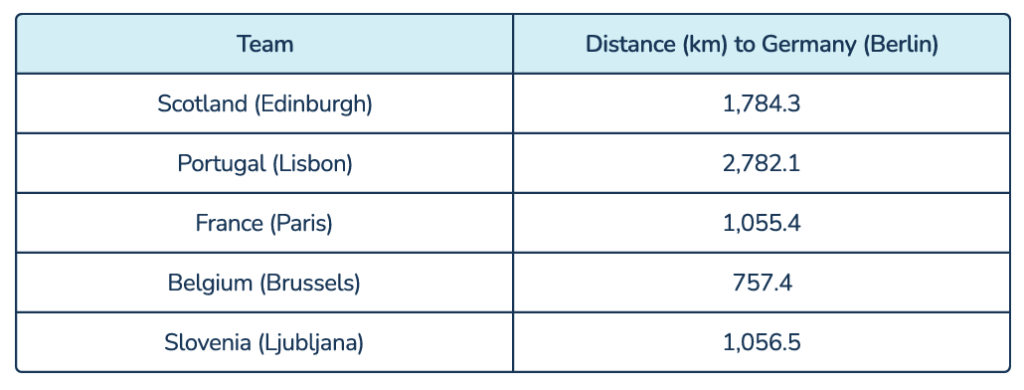
Distance calculation:
- Pupils calculate the total distance travelled by a team moving between their capital city and Berlin Germany (as the capital city) or the first location of a match (if known).
- Then calculate the distance between the team’s capital city and each match they attend. Example: London → Gelsenkirchen → Frankfurt → Cologne
Discussion questions:
- What is the total distance travelled by the team?
- How does travel distance impact a team’s performance?
- Why is it important to plan travel efficiently?
Data sources:
- Team capital to host city distances: Google Maps
7. Calculating fractions and percentages
National curriculum link: Year 6 Fractions (including decimals and percentages): use common factors to simplify fractions; use common multiples to express fractions in the same denomination
Duration: 30 minutes
Activity description: Pupils will calculate the average number of goals scored per match, average attendance, and other relevant averages from the UEFA Euros 2020.
Instructions:
- Explain why match statistics are interesting and important.
Data collection:
- Provide pupils with data for a specific match.
Example data from the 2024 Germany vs Scotland match:
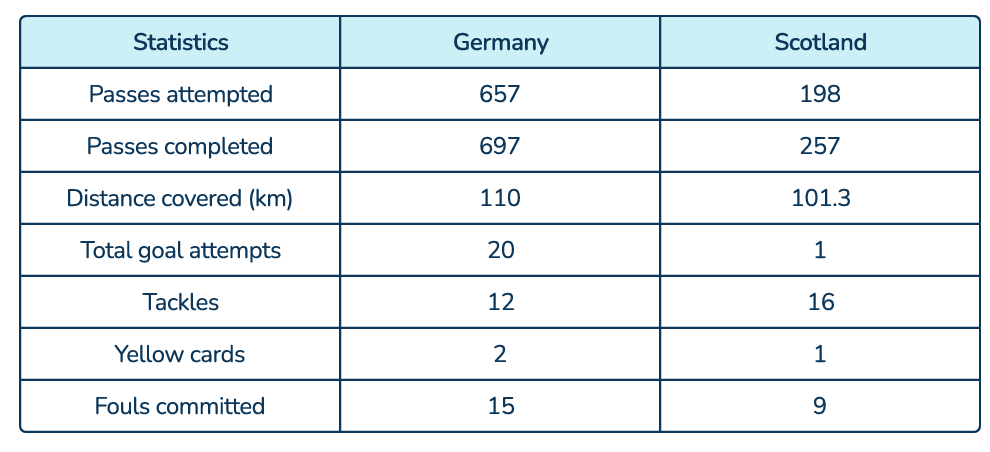
To make the calculations simpler, you could use theoretical data. Questions could also include finding the percentages for each statistic.
Calculating data:
There are a range of activities that learners could complete with match data, for example:
- What fraction of the total goals attempted did Germany make? Give the answer in its simplest form.
- What fraction of the total goal attempts did Scotland make? Give the answer in its simplest form.
- What fraction of fouls were committed by Scotland? Give the answer in its simplest form.
- What fraction of the passes completed were made by Germany? Give the answer in its simplest form.
Data sources:
- Match results and attendance: UEFA
DO YOU HAVE STUDENTS WHO NEED MORE SUPPORT IN MATHS?
Skye – our AI maths tutor built by teachers – gives students personalised one-to-one lessons that address learning gaps and build confidence.
Since 2013 we’ve taught over 2 million hours of maths lessons to more than 170,000 students to help them become fluent, able mathematicians.
Explore our AI maths tutoring or find out about primary school tuition for your school.
